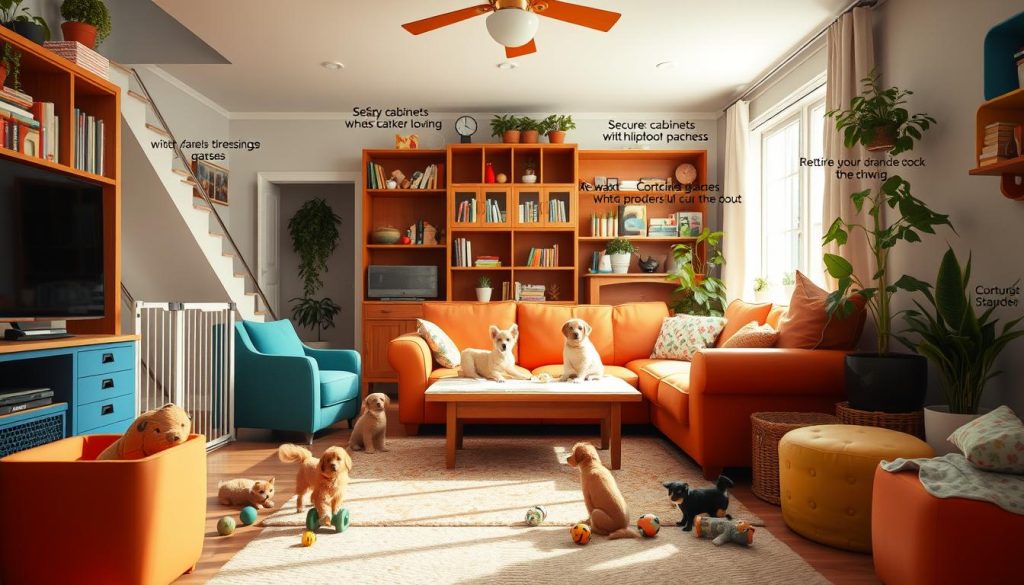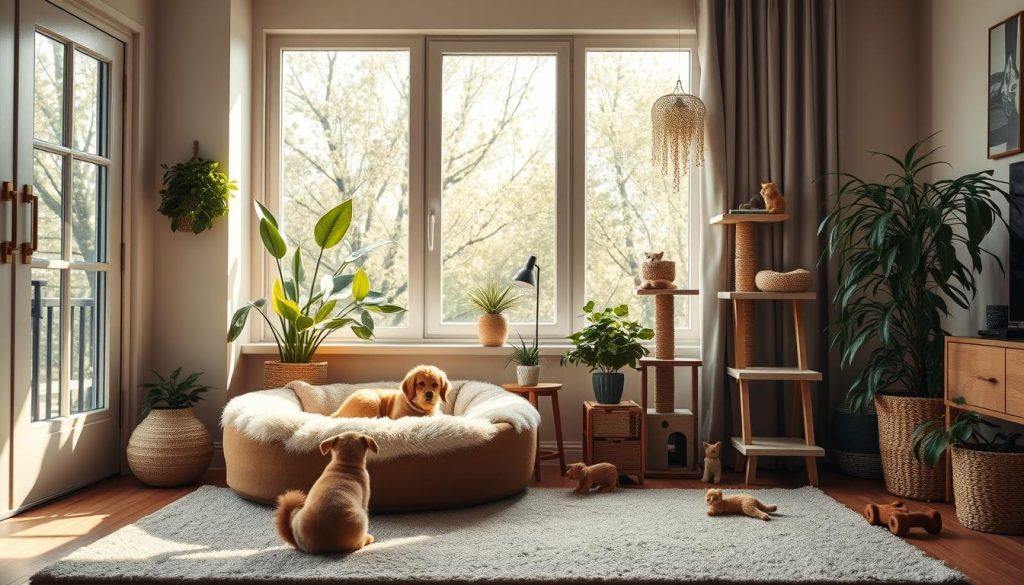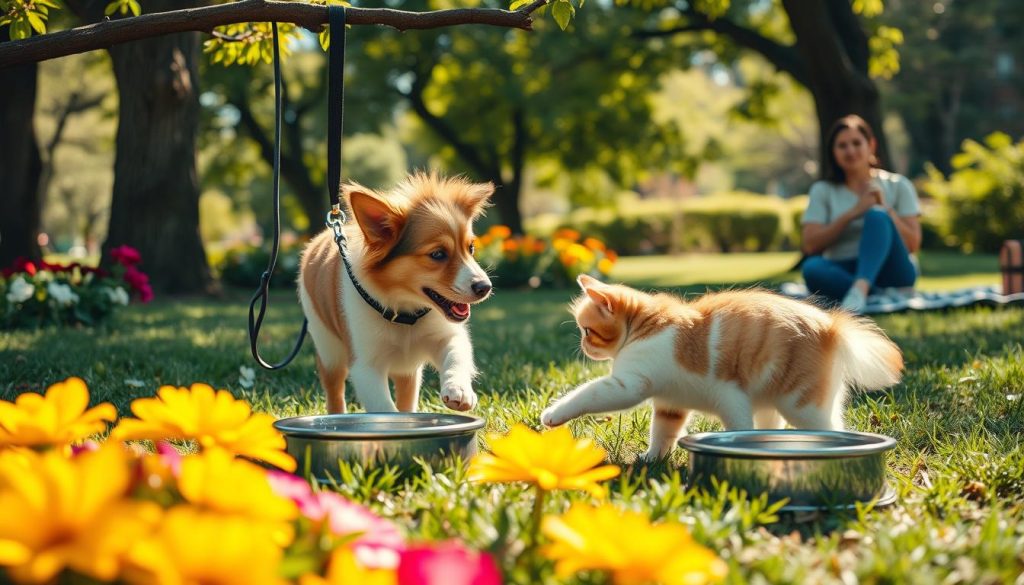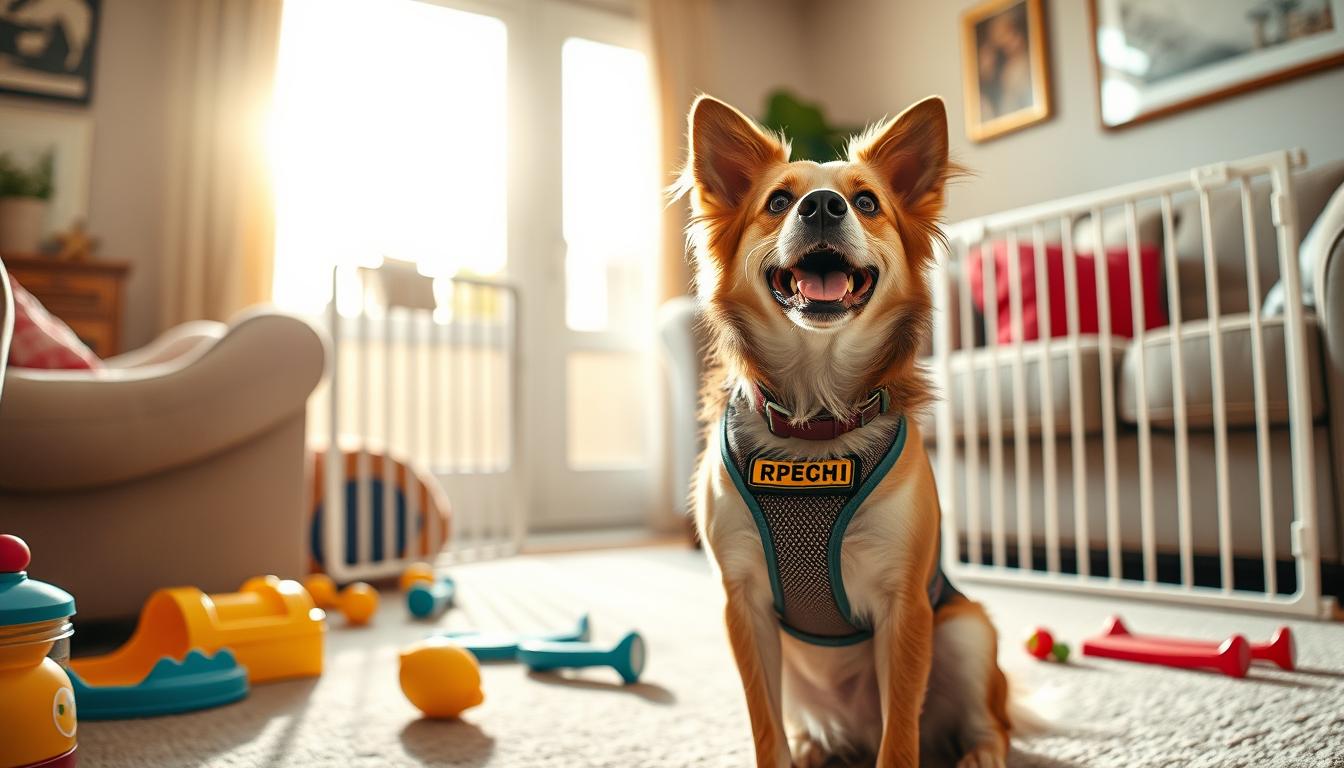As a devoted pet owner, keeping your furry friend safe is key. In this guide, I’ll share vital tips to make a safe and loving space for your pet. We’ll cover understanding risks and practical ways to pet-proof your home. This will help you protect your beloved companion.
Keeping your pet safe is essential, whether it’s a playful pup or a curious cat. By securing your home, you can avoid accidents that harm their health and happiness. In the next parts, we’ll explore why pet safety matters, share home pet-proofing tips, and discuss how to be a responsible pet owner for your pet’s well-being.
Understanding the Importance of Pet Safety
As a pet owner, keeping our furry friends safe is crucial. Pet safety is key to their health, happiness, and life span. Knowing the risks helps us make a safe space for them.
Why Pet Safety Matters
Pets are more than friends; they’re family. Keeping them safe shows we love and care for them. A safe home prevents accidents and keeps them healthy.
Potential Risks and Hazards
Our homes can hide dangers for pets. Things like cleaning supplies and plants can harm them. Learning about these dangers is essential to protect our pets.
| Potential Pet Hazards | Description |
|---|---|
| Toxic Substances | Household cleaning products, medications, certain plants, and even some human foods can be toxic to pets if ingested. |
| Choking Hazards | Small objects, toys, and even certain types of pet treats can pose a choking risk if swallowed by pets. |
| Electrical Cords | Exposed or dangling electrical cords can be a temptation for curious pets, leading to the risk of electric shocks or strangulation. |
| Furniture and Decor | Sharp edges, heavy objects, and small decorative items can cause injuries if pets interact with them. |
Knowing about pet safety helps us create a safe home for our pets. This not only improves their life but also strengthens our bond with them.
Securing Your Home Environment

Keeping your home safe for your pet is key to their happiness and safety. By taking simple steps to pet-proof, you can lower the chance of accidents. This way, you ensure your furry friend stays out of danger.
Pet-Proofing Your Living Spaces
It’s vital to make your home safe for your pet. Start by locking up cabinets, drawers, and electrical cords. This stops your pet from getting to things that could harm them. Also, make sure your home has good air flow and always have fresh water available for your pet.
Protecting your floors and furniture is also crucial. Use pet-friendly rugs or mats to save your floors from scratches. Choose durable, chew-resistant furniture to stop your pet from damaging things.
- Secure cabinets, drawers, and electrical cords
- Ensure proper ventilation and access to clean water
- Protect floors and furniture with pet-friendly materials
By pet-proofing your home, you make a safe and welcoming space for your pet. This improves their life and gives you peace of mind as a caring pet owner.
Pet safety

As a responsible pet owner, keeping your furry friend safe is key. Here, I’ll share important pet safety tips. These will help make your home a safe, loving space for your pet.
Proper Handling and Transportation
It’s vital to handle your pet gently to avoid injuries. Always support their body when picking them up. Never grab them by their legs or tail. Use a secure carrier or crate for safe travel.
Access to Essential Resources
Make sure your pet has clean water, good food, and a cozy place to rest. Check their bowls often. Give them a comfy, right-sized bed or crate for their safety and happiness.
Preventing Hazards and Accidents
- Keep your home safe by securing hazards like electrical cords and toxic chemicals. Also, keep small objects out of reach.
- Install safety gates to block off dangerous areas, like stairs or balconies.
- Check your home regularly for any pet safety risks, like loose tiles or sharp edges.
| Pet Safety Tips | Pet Care Best Practices | Preventing Pet Injuries | Pet-Friendly Home |
|---|---|---|---|
| Proper handling techniques | Providing access to clean water and nutritious food | Securing potential hazards | Designating safe, comfortable spaces |
| Secure transportation in carriers or crates | Maintaining a cozy resting area | Installing safety gates and addressing potential issues | Childproofing the home |
By following these tips, you can make a safe, loving home for your pet. Always put your pet’s safety first.
Responsible Pet Ownership Practices

Being a responsible pet owner means more than just a safe home. It’s about teaching your pet to be confident and ready for emergencies. I’ll talk about the value of training, socializing, and identifying your pet.
Training and Socialization
Training and socializing are key for pet ownership. Teaching your pet basic commands and introducing them to new things helps them grow into happy, well-adjusted friends. This improves their behavior and keeps them safe.
- Begin pet training early, using positive methods and being consistent.
- Introduce your pet to new people, animals, and places in a safe, positive way.
- Sign up for obedience classes or work with a pet trainer to make sure your pet learns well.
Proper Identification and Microchipping
Pet identification and microchipping are vital for pet safety. If your pet gets lost, the right ID can help bring them back home.
- Make sure your pet always wears a collar with current ID tags.
- Think about microchipping your pet for a permanent, reliable ID.
- Register your pet’s microchip with a national database to increase the chance of finding them.
By focusing on training, socializing, and ID, you show you care deeply about your pet. This keeps them safe and happy.
Outdoor Safety Considerations
As a pet owner, it’s vital to think about the challenges and risks of the outdoors. Keeping your furry friend safe on adventures is key. Let’s look at some important tips for handling environmental dangers, making sure they’re identified, and keeping them safe during outdoor fun.
When going outside, protecting your pet from environmental hazards is a big concern. The sun, extreme weather, toxic plants, and wildlife can all be dangers. Knowing these risks and taking steps to prevent them can help make outdoor spaces safer for pets.
It’s also crucial to ensure your pet has proper identification. Up-to-date tags, collars, and microchipping can help find them if they get lost. Using GPS tracking devices can add extra security and peace of mind when exploring with your pet.

